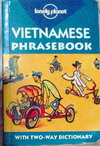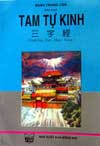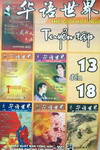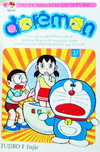
Pimsleur Vietnamese, published by Simon & Schuster Audio
About US$60, 10 lessons, 30 minutes each
![]()
This is a simple audio course offered by Pimsleur, a reputable way to teach foreign languages. This set consists of 10 lessons, each of about 30 minute, every lesson contains a simple conversation at the beginning, step by step the instructor will help you to decode the message. The publisher claimed that after 10 lessons you will be able to understand about 120 Vietnamese words and their usages. The so-called Pimsleur approach was actually quite repetitive, but they said this repetitiness is dfferent and innovative because every time when you are asked to repeat, the audio course gives you about 2 seconds to think, so it enhances your memory. I had finished this simple course before I came to Vietnam, I found it easy and quite enjoyed using it, it gave me some very brief concept of the sounds and structures of Vietnamese in a lazy-to-learn way, but there're some tricky and important sounds in Vietnamese (e.g. Ð) that you probably can't hear the differences in the audio. There's no written copy of the dialogues in this package which could be quite annoying if you wanted to see how they were written, though this may also be a part of the Pimsleur approach, which forces you to learn a language by your ears like what you did when you were young. The only drawback of this course is its price, US$60 for 300 minutes of repetitive instructions, just too expensive per minute but you can probably find this at your local library. Note that the audio instructions are all in Northern Vietnamese.
PS: If you're in Hong Kong, you can listen to this audio course at the Central Library, Causeway Bay.

Teach Yourself Vietnamese by Dana Healy, published by Hodder & Stoughton
About US$10, 268 pages, 18 lessons.
![]()
Good for beginners, though with quite a few careless mistakes. Cassette tapes use the Northern Accents and not clearly recorded so they are pretty useless. The pronunciation section at the beginning (with some mistakes again) is not clearly written so you have to find a Vietnamese firend to help you on this. The context is written in Northern Vietnamese (with almost no reference or hints of Southern Vietnamese), this can be frustrating if you're in the South. Lessons (18 in total) are quite well designed, with some cultural notes. This book is so far the most popular learning material for foreigners, and even the HCMC Publishing House (Nhà xuất bản TPHCM) got a license to produce this book (blue cover with a big Tiếng Việt, costs 28000 Ðồng). You may also consider the Colloquial Vietnamese (published by Routiledge) and it seems to be better than than the TY one.

Vietnamese the Rough Guide, published by the Penguin Group
About US$5 (second hand), 243 pages
![]()
Extremely useful and probably the first dictionary-cum-phrasebook for all Vietnamese learners (or just travellers in Vietnam) who can read English. A comprehensive English-Vietnamese word list covers all common words used in daily conversation, in some words simple dialogues are provided. The Vietnamese-English section is rather weak. Original version of this book can be difficult to be found in Vietnam, I've bought mine in an old bookstore near Pham Ngu Lao in Ho Chi Minh City. There're some illegal photocopies sold in Vietnam with very unclear letters (you can't see the diacritics and tonal markers), so don't save your money.
If you can't find this one, an alternative is to use Tư điển Anh-Việt (English-Vietnamese Dictionary) by HỒ Hải Thụy, published by Nhà xuất bản TPHCM (see below), which is equally good, just thicker.

Vietnamese Phrasebook, published by the Lonely Planet
About US$8, 280 pages
![]()
Poorly designed, almost useless and very disappointing, probably one of the worst LP phrasebooks on the market. Vocabulary list is not as comprehensive as the Rough Guide (see above), the tiny (*tiny!) dictionary at the back doesn't even have the word "spoon"! This phrasebook is, however, much more popular than the Rough Guide because of the "reputation" and popularity of the Lonely Planet.

Tư điển Anh-Việt (English-Vietnamese Dictionary) by HỒ Hải Thụy, published by Nhà xuất bản TPHCM
24000 Ðồng, 764 pages
![]()
Comprehensive list of vocabulaires in a pocket-sized dictionary, with very good examples in English and Vietnamese using simple words, clearly explained, though it's intended for English learners of Vietnamese, I still recommend it for intermediate Vietnamese learners.


Từ điển Hoa-Việt / Việt-Hoa (华越/越华学生词典), published by Nhà xuất bản thông vận tải
20000 Ðồng (each), 647 pages (each)
![]()
If you know Chinese, it's good to learn some Vietnamese using Chinese because they're quite related and you'll save your time for memorizing vocabularies. There're a lot of Chinese-Vietnamese dictionaries in Vietnam, but most are badly designed, words are old-fashed, the small pocket dictionaries are all without examples, and those with examples are just too big to carry around. These two dictionaries are definitely not the best you could find, but I bought them and found them (sometimes) useful. Note that these two dictionaries use the Simplified Chinese script.

Từ điển Việt Hán Hán Việt 越漢漢越詞典, published by Nhà xuất bản thanh hóa
29000 Ðồng, 1187 pảages
![]()
With more vocabularies and examples than the the dictionaries above, this dictionary is better though I can't really recommend it, you may have a better chance to find some other similar Chinese dictionaries in Vietnam. Note that this dictionary was printed in Traditional Chinese script.

Từ điển ngữ pháp tiếng Việt cơ bản by Nguyễn Văn Huệ, published by Nhà xuất bản đại học quốc gia TPHCM
58000 ốÐồng, 418 pages
![]()
Extremely useful. Vietnamese can be difficult because of the existence of so many words with vague meanings. e.g. được, lại, mà, etc. This book contains 103 of such words with very detailed explanation and the book was printed in both Vietnamese (on the left) and English (on the right). Each word contains situations (of usage), examples, summaries and related expressions. Highly recommended for intermediate learners. But keep in mind that this is a grammar book only and it doesn't necessarily reflect how people use the language, in the description of "lại" (p. 181) it said that "Lại, as a verb of movement, indicates movement in a sphere which is considered close.", which is not precisely right. Vietnamese are quite flexible on these rules.

Học Chữ Nôm by Vũ Văn Kính 學[宁字]喃, published by Nhà xuất bản cà mau
19000 ảốÐồng, 186 pảages
![]()
Vietnamese was written in Chinese characters and Chữ Nôm (Vietnamese-made Chinese characters) about a century ago. Though most Vietnamese know almost no Chữ Nôm now, it's still quite interesting to learn some, just for fun especially if you know Chinese already, and I found that learning Chữ Nôm enhances my memory of Vietnamese words . This book is not very good however, the Chinese characters were written by hand and were not clearly printed. The only reason to buy this book is because there're some old passages written in Chữ Nôm (which can be difficult to find on internet) on page 139 - 153, and the translation (in latinized alphabets) are on page 154 -185. I have to tell you the page numbers here too because the book is quite badly organized.

Ðại từ điển Chữ Nôm, by Vũ Văn Kính 大字典[宁字]喃, published by Nhà xuất bản văn nghệ TPHCM và Trung tâm nghiên cứu quốc học
180000 ảốÐồng, 1598 pảages
![]()
Written by the same author of the above book, but this one is much clearer, characters are still written by hand but are bigger. The Chữ Nôm list is comprehensive but not complete though this is understandable because of the lack of standard throughout the history of using Chữ Nôm. This book is the heaviest book in this Reference list, and here's a sample page.
Note that "Y" is indexed after "I" instead of "X" and so if you want to know how to write "Yêu" (love) in Chữ ôm, turn to page 619 please. If you're just interesting to know some forms of Chữ Nôm, you can visit the impressive lookup tool provided by the Nom Foundation.

Tam Tự Kinh (Trình bày Việt - Hán - Nôm) 三字經, by Ðoàn Trung Còn, published by NXB Ðồng Nai
10000 Ðồng
![]()
If you know Chinese already, then this book is so far the best self-learning material for Chữ Nôm. 三字經 (Sānzì Jīng) was a Chinese text (not really a "jīng" indeed) and was taught to Vietnamese children in the old times. This book contains a word-by-word literal translation of the Chinese text into Vietnamese chữ nôm and quốc ngữ, then a complete text of translation in modern Vietnamese, plus some footnotes mostly related to Chinese history. But as mentioned above, Vietnamese chữ nôm had never been standardized so even in this thin little book, sometimes different chữ nôms were written though referring to the same thing, e.g. lên was written as "上連" (p.48) and "升連" (p.58) and lớn was "大吝" (p.15) or "吝大" (p.29). Though both nôms are correct, I think it's strange to use different characters in the same book, yet again, it demonstrates the non-systematic usage of this writing system. Here's a sample page.

Thế giới hoa ngữ 华语世界
45000 ữ Ðồng (6 issues) or 8000 Ðồng (1 issue)
![]()
It's indeed a magazine for Vietnamese who are learning Chinese. Equipped with quite a lot of cultural and historic information about China, most texts have side-by-side Vietnamese translations, but articles chosen are quite boring, some jokes, some stupid advise (usually about love affairs), and some proverbs like "lý do cuả tình yêu chính là không có lý do" (the reason of love, is of no reason), these can make some good conversations with your Vietnamese friends though. One issue costs 8000 Ðồng, there's a version with 6 issues in one, costs 45000 Ðồng.

1300 Câu đàm thoại tiếng Hoa 掌握华语, published by Nhà xuất bản thanh hóa
39000 ảốÐồng, 715 pảages
![]()
With 1300 sentences of daily conversation in 156 short lessons, I found this book one of the most useful studying materials and is hỉghly recommended. The content are translated in Vietnamese, Simplified Chinese (with pīnyīn) and English, so it makes very good comparison of these 3 languages (Vietnamese can be quite similar to both Chinese and English in different situations). There's no grammar note in this book but it's strong on vocabulary and daily expression, it's indeed a simple story of the Vương's family of Singapore (oh why Singapre?) so it provides some clues for you to trace back the vocabularies you have learnt. Some vocabularies or situations, however, are not applicable in Vietnam, e.g. Chapter III-26 said, "Một người đàn ông bị cảnh sát bắt khi đang tiểu tiện trong thang máy." (A man was caught urinating in the lift by the police.) --- A most impossible situation to be happened in Vietnam, because: 1. Most Vietnam residential areas don't have lift. 2. It's almost "legal" to pee everywhere...

Lịch sử Việt Nam bằng tranh (Vietnam history in comics) published by Nhà xuất bản trẻ
9000 ữ Ðồng (each), 103 pages
![]()
This comics series has more than 27 books so far, and it makes a good and simple reading of the Vietnamese history written by Vietnamese for Vietnamese in Vietnamese. They even have some illustrated maps and photos. However the Chữ Nôm drawn in the comics was rather laughable, or maybe I'm just too picky? It's a book for kids anyway.

Lac Viet electronic dictionary (website)
freeware, works on Windows 98, 2000 and XP
![]()
An electronic dictionary run on Windows environment, the "autolook" function is extremely useful and it allows you check the vocabulary instantly on any website, it has an amazingly large stock of vocabularies with synthesized pronunciation, highly recommended for all levels of learners. You can download the program for free (freeware). However, just don't trust the TTS (text-to-speech) pronunciation of this program, they sound quite ugly to Vietnamese ears.

Hán Việt electronic dictionary (website)
freeware, run on Java platform
![]()
This is a dictionary compiled by a Vietnamese in Paris. An extremely useful tool for studying Vietnamese if you know Chinese already, just input the Chinese characters (with your own input method, or with the program's lookup tool), you can get the relevant Vietnamese pronunciation on a fly. It's so far the most useful and convenient tool to study the transition of Chinese sounds into Vietnamese. And there's also a function that let you convert a paragraph of Chinese into the Hán Việt pronunciation, e.g. just type in 菩提本無樹, 明鏡亦非臺, 本來無一物, 何處惹塵埃 then you can get instantly "bồ (đề, thì, để) (bổn, bản) (vô, mô) thụ , minh kính diệc phi (thai, đài, di) , (bổn, bản) (lai, lãi) (vô, mô) nhất vật , hà (xử, xứ) nhạ trần ai". You have to download the Java machines to run this dictionary. But this progrm
The installation manual of this dictionary wasn't clearly written, but if you can't run the program (a file with jar as extension), go to the DOS Command Prompt under Windows (or go to "Run" from the Start Menu on the left bottom corner, then type in "CMD"), then type in "java -jar c:\hanviet.jar" and press Enter. The TDDT runs using the same way, check their manual, it's easier for newbie to understand.

TDDT ( website )
free, run on Java platform
![]()
This dictionary is not as good as Lac Viet (see above), but it's free too. It has two language packs, one with two-way Vietnamese English, the other with Vietnamese-Vietnamese. The online version of this dictionary is far better, with human proununciation too.

WinVNkey (website)
freeware, run on Windows 2000 and XP
![]()
Some notes about the Vietnamese encoding: there used to have a few encoding systems but now the standard is Unicode Vietnamese which is used in most Vietnamese website now (including this one). There're some programs to input Vietnamese diacritics in computer, WinVNkey is a freeware. Several input methods are available, some are difficult to use (and probably faster for skilled typist), some are easy to learn (one minute and you know how to use it) but slower. The most popular Vietnamese input method for Vietnamese is either VNI or Telex, but you have to remember quite a few keys which I don't like. I prefer is "VIQR", which is as easy as 123. Type dd to get đ, a^ for â, a( for ă, o+ for ơ, etc. It's so apparent that learning is just not needed.
You can also configure this program with your own macros, I've made a simple macro for typing Chinese pinyin (in Unicode), type pin1yin2 and you can get pīnyīn, etc. The macro file can be downloaded here, check the manual of WinVNkey to see how to install it.

Japanese comics translated into Vietnamese
About 6000 Ðồng
![]()
Well... they're easy to read, aren't they? And the comics is written in childish but casual Vietnamese, so it's a good starter for daily conversation. It also makes clearer of my concept of the various "you" in different situations.